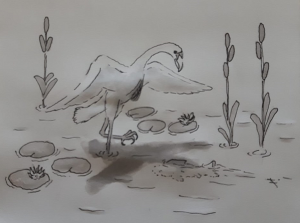Ghost Crane
From World of Entorais Wiki
Revision as of 02:27, 20 April 2023 by Sebastian Romu (talk | contribs) (Text replacement - "Sub-Species" to "Notable Sub-Species")
About
- Common Names
- Ghost Crane, Shadow Fisher
- Classification
- Bird
- These birds hunt for fish in shallow wetlands by standing with their backs to the sun and their wings spread to create a shadow which attracts fish wishing to escape the hot sun. Standing on a single stilt-like leg the crane strikes with its raptor talons.
Description
- Size
- Appearance
- Tall standing birds with long necks, legs ending in raptor-like talons. White in colour with grey legs.
- Sexual Dimorphism
- Male Ghost Cranes possess a tassel of black bristle like feathers at their breast.
- Variance
- None.
Ecology
- Habitat
- Migratory; Tropical to Sub-arctic Wetlands
- Diet
- Carnivorous, eating a variety of fish, amphibians, and aquatic reptiles.
Behaviour
- Social grouping
- Small flocks numbering up to a dozen individuals.
- Temperament
- Aggressive, will attack or chase off potential threats to their young, or favoured fishing spots.
- Intelligence
- Animal
- Reproduction
- After mating in early spring, females will brood one to three eggs in a grassy nest near water. After hatching these young cranes will learn to hunt small minnows and other aquatic prey in the shallows before moving on to bigger prey in deeper water as adults. These young will be ready to fly by the time the autumnal migration is upon them.
- Migratory
- Ghost cranes migrate with the seasons, wintering in the tropics, moving towards more temperate latitudes with the onset of spring.
- Shadow Fishing
- These birds hunt for fish in shallow wetlands by standing with their backs to the sun and their wings spread to create a shadow which attracts fish wishing to escape the hot sun. Standing on a single stilt-like leg the crane strikes with its raised foot, grasping prey with raptor-like talons.
Notable Sub-Species
- No known sub-species
Domestication
- General
- Given the migratory nature they are difficult to keep, however some cultures have managed to utilize such birds, training them as fishing animals.
- Resources
- Meat, Feathers, Eggs.
